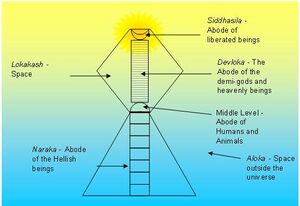Religion:Ākāśa (Jainism)
Ākāśa is space in the Jain conception of the cosmos. Akash is one of the six dravyas (substances) and it accommodates[1] the other five, namely sentient beings or souls (jīva), non-sentient substance or matter (pudgala), principle of motion (dharma), the principle of rest (adharma) and time (kāla)
Akasha provides the space for other substances.[2] Akasha does not act as an obstruction. There are two types of Ākāśa: Lokakasha and Alokakasha. Alokakasha is beyond the Lokakasha and is empty; it has no other substance. [3]
Etymology
Ākāśa is a compound word of Sanskrit language, wherein "ā" refers to "towards" and "kāśa" refers "to be visible or to appear".[5] Thus, Akasha is the subtle “background” against which everything in the material universe becomes perceptible.[6]
Attributes
Space provides room to all other substances of the universe. The characteristic of space is to give room to or accommodate the other substances. The special feature of space is that it is not restricted to the universe like other substances but extends beyond the universe to the non-universe.
Its qualities are as follows:[7]
- Provides room to soul, matter, medium of motion, and medium of rest
- Pervades everywhere (infinite)
- Supports everything and thus it is self supported
- Have no form, color, taste, smell, and touch
- Does not perform any active action (inactive)
- Provides accommodation to soul and matter of their actions
- Is one and whole
Sky and space both are different. We can see the sky because it is modification of the Pudgala whereas space is invisible.[8]
Types of Akasha
Space substance is only one substance and as such it is indivisible (akhand).[9] However, universe (lokakasha) and non-universe (alokakasha) are considered its two divisions. Space is divided into two parts:
- Lokakas - Where medium of motion and rest substances exist
- Alokakas - The remaining space, which is empty and void.
The dimension of Lokakasha is fourteen rajlok or rajju, however Alokakasha is infinite.[10]
Lokakasha
That portion of space in which all the substances are found is called the universe (lokakash). There are three types of Lokakasha; a) Urdhwa Lok, where beings of higher qualities than us live (Siddha Lok where liberated souls stay is at the top of Urdhwalok), b) Madhya Lok - where human beings and other creatures live, and c) Adho Lok, where the inmates of hell live (it has seven layers).
At the summit of the lokākāśa is the Siddhashila (abode of the liberated souls).[11]
The dharma & adharma dravyas are present only in Lokakasha and that is why jiva and pudgal are also there in the Lokakasha only.[12]
Alokakasha
The (empty) infinite space outside the universe is called the non-universe (alokakash). In the non-universe, space alone exists without the other five substances. Actually in non-universe there is nothing but space.[14]
Alokakash is perceptible only to the omniscient.
References
- ↑ Uttaradhyan sutra, Ch. 28
- ↑ http://nirgranth.in/6-dravya/
- ↑ http://www.jainbelief.com/PPOJ/10.htm
- ↑ http://www.jainsamaj.org/content.php?url=Jainism_-_Jain_Cosmology:-_By
- ↑ http://www.herenow4u.net/index.php?id=73983
- ↑ Yogananda 2007, p. 867.
- ↑ https://sites.fas.harvard.edu/~pluralsm/affiliates/jainism/jainedu/6dravya.htm
- ↑ http://www.jainpushp.org/munishriji/ss-5-seven-tattava.htm
- ↑ http://www.atmadharma.com/shastras/laghujainsiddhant_eng_txt/index.html
- ↑ https://sites.fas.harvard.edu/~pluralsm/affiliates/jainism/jainedu/6dravya.htm
- ↑ Sharma, C. (1997). A Critical Survey of Indian Philosophy, Delhi: Motilal Banarsidass, ISBN:81-208-0365-5, p.64
- ↑ http://jainascience.blogspot.in/2007/12/six-substancesdravyas-in-jain.html
- ↑ http://mangitungi.org/JainismNScience.aspx
- ↑ https://www.jainbooks/firstep-1/dravya.htm


